The Universe Has Been Reading Our Wishlist Again I Know You Are
What if the Universe has no cease?
(Paradigm credit:
Getty Images
)
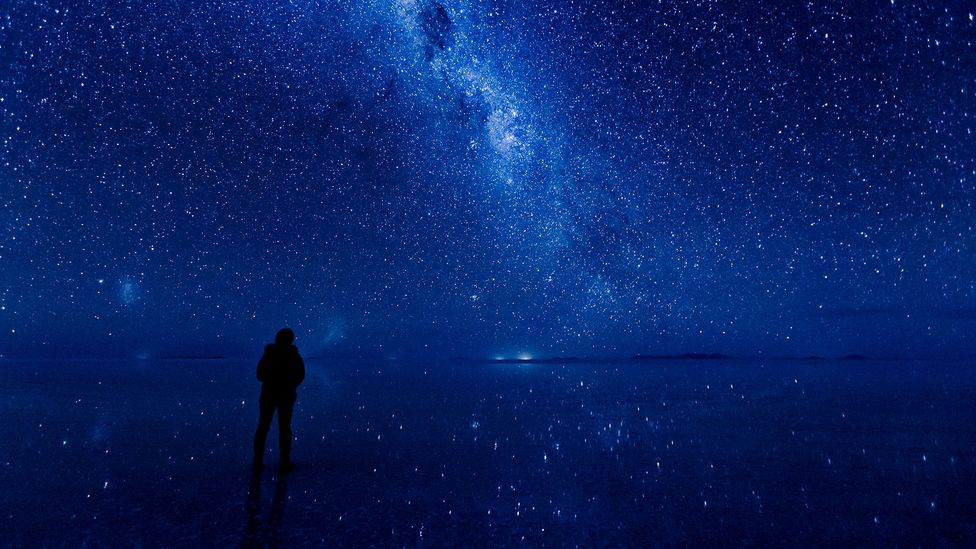
The Big Bang is widely accepted as being the beginning of everything we meet around us, but other theories that are gathering support among scientists are suggesting otherwise.
T
To marking the terminate of a turbulent year, we are bringing back some of our favourite stories for BBC Time to come's "Best of 2020" drove.Observe more than of our picks here.
The usual story of the Universe has a beginning, middle, and an end.
It began with the Big Bang 13.8 billion years ago when the Universe was tiny, hot, and dense. In less than a billionth of a billionth of a second, that pinpoint of a universe expanded to more than a billion, billion times its original size through a procedure called "cosmological aggrandizement".
Adjacent came "the svelte go out", when aggrandizement stopped. The universe carried on expanding and cooling, but at a fraction of the initial rate. For the side by side 380,000 years, the Universe was so dense that non fifty-fifty light could move through it – the creation was an opaque, superhot plasma of scattered particles. When things finally cooled enough for the first hydrogen atoms to course, the Universe swiftly became transparent. Radiations outburst out in every management, and the Universe was on its way to becoming the lumpy entity we come across today, with vast swaths of empty space punctuated by clumps of particles, dust, stars, black holes, galaxies, radiation, and other forms of affair and energy.
You might as well like:
• Did "night stars" aid class our universe
• The photo that summed upwards our identify in the Universe
• Is there a hidden code that rules the Universe
Eventually these lumps of affair will drift so far autonomously that they will slowly disappear, co-ordinate to some models. The Universe will become a cold, uniform soup of isolated photons.
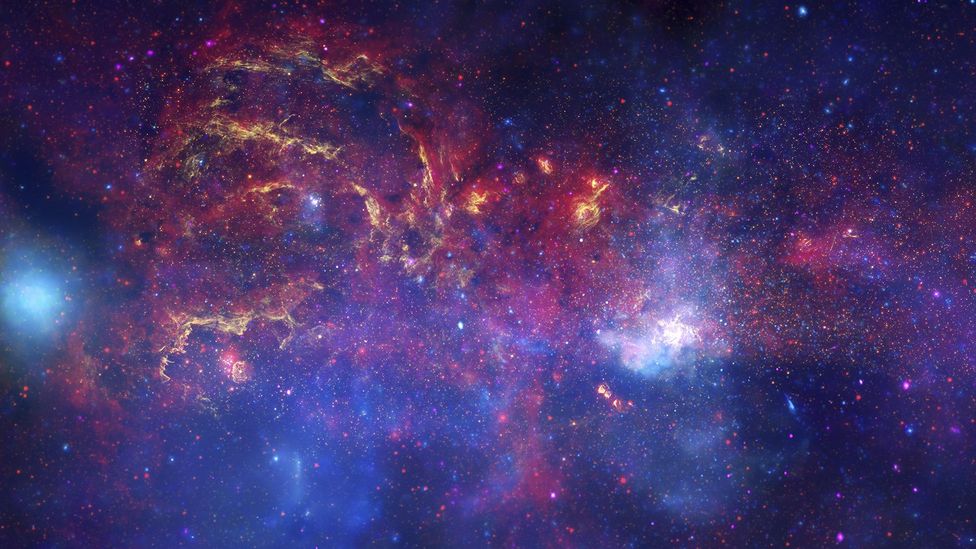
The Universe we can currently meet is made up of clumps of particles, dust, stars, black holes, galaxies, radiation (Credit: NASA/JPL-Caltech/ESA/CXC/STScI)
Information technology's not a particularly dramatic catastrophe, although information technology does have a satisfying finality.
Merely what if the Big Bang wasn't actually the start of it all?
Perchance the Big Bang was more of a "Big Bounce", a turning signal in an ongoing cycle of wrinkle and expansion. Or, it could exist more like a point of reflection, with a mirror epitome of our universe expanding out the "other side", where antimatter replaces matter, and fourth dimension itself flows backwards. (There might even be a "mirror yous" pondering what life looks like on this side.)
Or, the Large Bang might be a transition point in a universe that has always been – and ever will be – expanding. All of these theories sit outside mainstream cosmology, just all are supported past influential scientists.
The growing number of these competing theories suggests that information technology might now be time to permit go of the idea that the Large Blindside marked the start of space and time. And, indeed, that it may even accept an terminate.
Many competing Big Bang alternative stem from deep dissatisfaction with the idea of cosmological inflation.
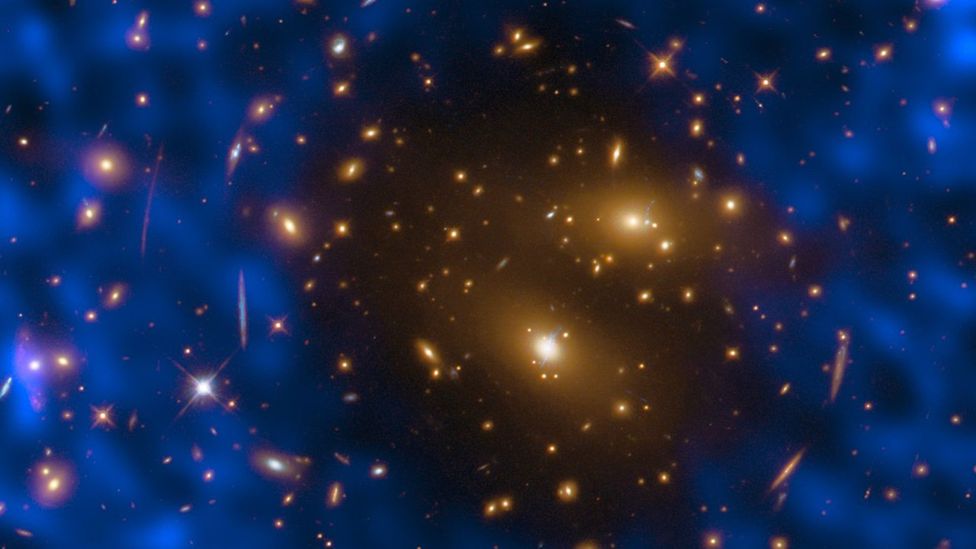
Scars left by the Big Blindside in a weak microwave radiation that permeates the unabridged cosmos provides clues nigh what the early on Universe looked like (Credit: Nasa)
"I have to confess, I never liked inflation from the start," says Neil Turok, the one-time director of the Perimeter Constitute for Theoretical Physics in Waterloo, Canada.
"The inflationary image has failed," adds Paul Steinhardt, Albert Einstein professor in scientific discipline at Princeton Academy, and proponent of a "Big Bounce" model.
"I always regarded aggrandizement every bit a very artificial theory," says Roger Penrose, emeritus Rouse Ball professor of mathematics at Oxford University. "The master reason that it didn't die at nascence is that it was the just thing people could call up of to explain what they call the 'scale invariance of the Cosmic Microwave Groundwork temperature fluctuations'."
The Catholic Microwave Groundwork (or "CMB") has been a fundamental factor in every model of the Universe since information technology was commencement observed in 1965. Information technology'southward a faint, ambient radiations found everywhere in the appreciable Universe that dates back to that moment when the Universe offset became transparent to radiations.
The CMB is a major source of information about what the early Universe looked similar. Information technology is also a tantalising mystery for physicists. In every direction scientists point a radio telescope, the CMB looks the aforementioned, fifty-fifty in regions that seemingly could never take interacted with 1 another at any point in the history of a xiii.8 billion-year- old universe.
"The CMB temperature is the same on opposite sides of the sky and those parts of the sky would never take been in causal contact," says Katie Mack, a cosmologist at Northward Carolina Land University. "Something had to connect those two regions of the Universe in the past. Something had to tell that part of the heaven to be the same temperature as that office of the heaven."
Without some mechanism to even out the temperature across the appreciable Universe, scientists would expect to meet much larger variations in different regions.
Inflation offers a way to solve this so-called "homogeneity trouble". With a period of insane expansion stretching out the Universe so rapidly that almost the unabridged thing ended up far across the region we tin can discover and interact with. Our observableuniverse expanded from one tiny homogenous region within that primordial hot mess, producing the uniform CMB. Other regions beyond what we tin can notice might look very unlike.
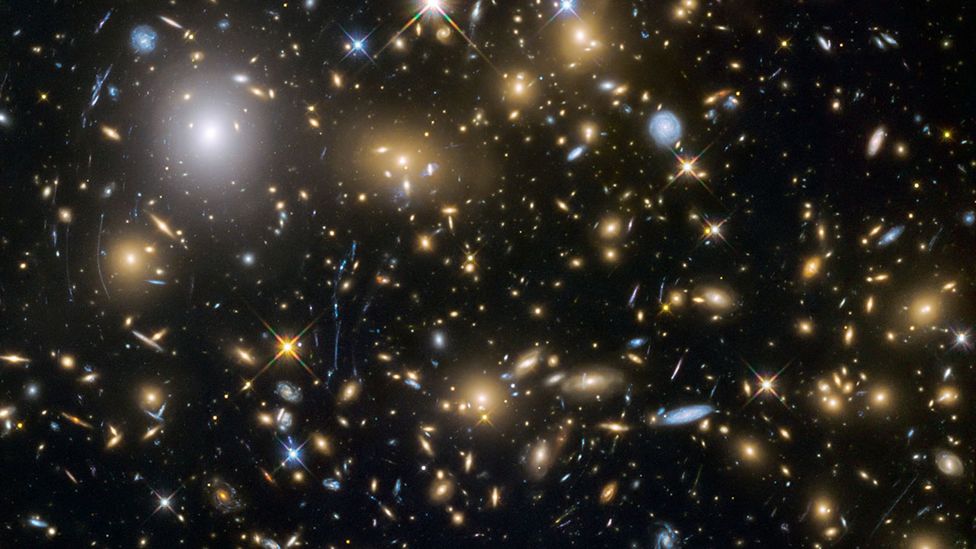
Theoretical physicists are increasingly finding that inflation theory fails to business relationship for the spread of matter and energy observed in the Universe (Credit: Nasa/ESA)
"Aggrandizement seems to be the thing that has enough support from the data that we tin can take it as the default," says Mack. "It's the one I teach in my classes. But I always say that we don't know for sure that this happened. Simply it seems to fit the information pretty well, and is what nearly people would say is most likely."
Only at that place have always been shortcomings with the theory. Notably, at that place is no definitive machinery to trigger inflationary expansion, or a testable caption for how the svelte ending could happen. Ane idea put forward by proponents of inflation is that theoretical particles made up something called an "inflation field" that drove inflation and then rust-covered into the particles nosotros run across effectually u.s. today.
But even with tweaks like this, inflation makes predictions that accept, at least thus far, not been confirmed. The theory says spacetime should be warped by primordial gravitational waves that ricocheted out beyond the Universe with the Big Blindside. But while certain types of gravitational waves take been detected, none of these primordial ones have yet been establish to back up the theory.
Breakthrough physics also forces inflation theories into very messy territory. Rare quantum fluctuations are predicted to cause inflation to pause space up into an space number of patches with wildly different properties – a "multiverse" in which literally every imaginable event occurs.
"The theory is completely indecisive," says Steinhardt. "It can just say that the appreciable Universe might be like this or that or whatever other possibility you lot can imagine, depending on where nosotros happen to be in the multiverse. Cypher is ruled out that is physically believable."
Steinhardt, who was one of the original architects of inflationary theory, ultimately got fed up with the lack of predictiveness and untestability.
"Do we really demand to imagine that at that place exist an infinite number of messy universes that we take never seen and never will come across in order to explain the one simple and remarkably polish Universe nosotros actually observe?" he asks. "I say no. We accept to look for a better thought."
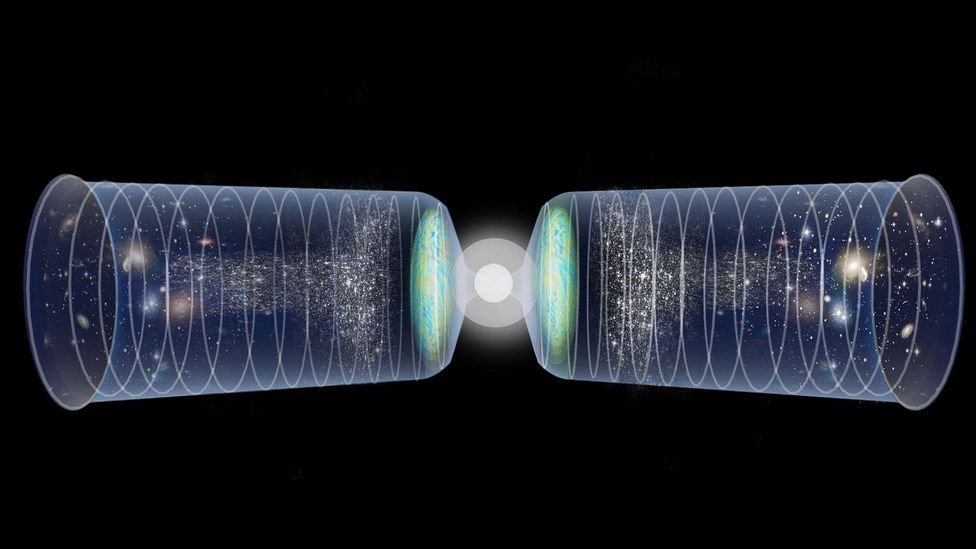
Rather than being a kickoff, the Big Bang could take been a moment of transition from one period of space and time to some other – more than of a bounce (Credit: Alamy)
The trouble might take to do with the Big Blindside itself, and with the idea that in that location was a outset to infinite and fourth dimension.
The "Big Bounce" theory agrees with the Big Blindside picture show of a hot, dense universe thirteen.eight billion years ago that began to expand and cool. But rather than being the beginning of space and time, that was a moment of transition from an earlier phase during which infinite was contracting.
With a bounce rather than a bang, Steinhardt says, afar parts of the cosmos would have plenty of time to interact with each other, and to form a single smooth universe in which the sources of CMB radiations would have had a chance to even out.
In fact, it'south possible that time has existed forever.
"And if a bounciness happened in our by, why could there not have been many of them?" says Steinhardt. "In that case, it is plausible that at that place is one in our futurity. Our expanding universe could start to contract, returning to that dense state and starting the bounce cycle again."
Steinhardt and Turok worked together on some early versions of the Large Bounce model, in which the Universe shrunk to such a tiny size that quantum physics took over from classical physics, leaving the predictions uncertain. But more recently, another of Steinhardt'southward collaborators, Anna Ijjas, adult a model in which the Universe never gets and so small that breakthrough physics dominates.
"It's a rather prosaic, conservative idea described at all times by classical equations," Steinhardt says. "Inflation says in that location's a multiverse, that there'south an infinite number of ways the Universe might come out, and we just happen to live in the one that is smooth and flat. That's possible only not likely. This Large Bounce model says this is how the Universe must be."
Neil Turok has also been exploring another artery for a simpler culling to inflationary theory, the "Mirror Universe". It predicts that another universe dominated by antimatter, but governed by the aforementioned physical laws as our own, is expanding outwards on the other side of the Big Bang – a kind of "anti-universe", if you like.
"I take one thing abroad from the observations of the last thirty years, which is that the Universe is unbelievably simple," he says. "At large scales, it is not chaotic. It is not random. It'due south incredibly ordered and regular and requires very few numbers to draw everything."

Our forward-time flowing universe could take a perfect reflection that also extends out in contrary from the event nosotros telephone call the Large Bang (Credit: Alamy)
With this in listen, Turok sees no identify for a multiverse, higher dimensions, or new particles to explain what can be seen when nosotros look up at the heavens. The Mirror Universe offers all that – and might also solve ane of the Universe's big mysteries.
If you add up all the known mass in a galaxy – stars, nebulae, blackness holes and and so on – the total doesn't create enough gravity to explain the motion inside and between galaxies. The remainder seems to be fabricated up of something we cannot currently see – dark matter. This mysterious stuff accounts for about 85% of the matter in the universe.
The Mirror Universe model predicts that the Big Bang produced a particle known as "right-handed neutrinos" in affluence. While particle physicists accept nevertheless to straight see any of these particles, they are pretty sure they exist. And it is these that brand up nighttime matter, according to those who support the Mirror Universe theory.
"It'due south the only particle on that listing (of particles in the Standard Model) that has the two requisite backdrop that nosotros haven't directly observed information technology yet, and it could exist stable," says Latham Boyle, another leading proponent of the Mirror Universe theory and a colleague of Turok at the Perimeter Institute.
Peradventure the nearly challenging alternative to the Large Blindside and inflation is Roger Penrose's "Conformal Cyclic Cosmology" theory (CCC). Like the Big Bounce, it involves a universe that might have existed forever. Simply in CCC, it never goes through a period of contraction – information technology only always expands.
"The view I have is that the Large Bang was not the beginning," says Penrose. "The entire pic of what we know nowadays, the whole history of the Universe, is what I call i 'aeon' in a succession of aeons."
Penrose's model predicts that much of the matter in the Universe will somewhen be dragged into ultra-massive black holes. Equally the Universe expands and cools to near absolute zero, those black holes will "boil away" through a phenomenon called Hawking Radiation.
"You have to retrieve in terms of something like a googol years, which ways a number one with 100 zeros," says Penrose. "That's the number of years or more for the really big ones to finally evaporate away. Then you've got a universe really dominated by photons (particles of light)."
Penrose says at this point, the Universe begins to look much as information technology did at its start, setting the stage for the start of another aeon.
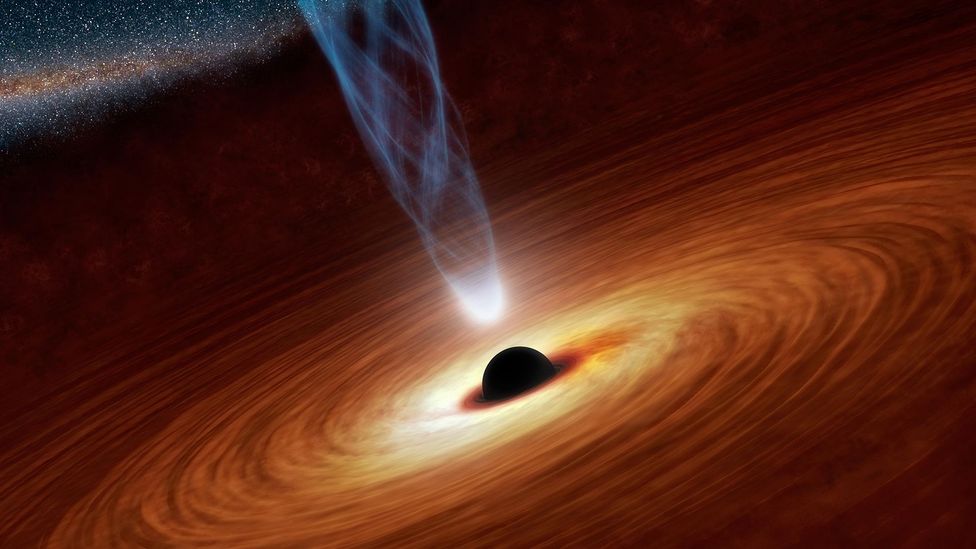
Conformal Cyclic Cosmology predicts that much of the Universe will exist pulled into enormous black holes that will then boil away (Credit: NASA/JPL-Caltech)
One of the predictions of CCC is that in that location might exist a record of the previous aeon in the cosmic microwave groundwork radiation that originally inspired the aggrandizement model. When hyper-massive black holes collide, the impact creates a huge release of energy in the grade of gravitational waves. When behemothic black holes finally evaporate, they release a huge corporeality of free energy in the form of low-frequency photons. Both of these phenomena are and then powerful, Penrose says, that they can "burst through to the other side" of a transition from i aeon to the next, each leaving its own kind of "betoken" embedded in the CMB like an echo from the past.
Penrose calls the patterns left behind by evaporating black holes "Hawking Points".
For the first 380,000 years of the current aeon, these would accept been nothing more than tiny points in the cosmos, but as the Universe has expanded, they would announced as "splotches" across the sky.
Penrose has been working with Polish, Korean and Armenian cosmologists to see if these patterns can actually be plant by comparing measurements of the CMB with thousands of random patterns.
"The conclusion we come to is that we encounter these spots in the sky with 99.98% confidence," Penrose says. The physics world has, however, remained largely skeptical of these results to date and in that location has been limited interest among cosmologists about even attempting to replicate Penrose's analysis.
Information technology is unlikely that nosotros will e'er be able to directly observe what happened in the offset moments after the Big Bang, let alone the moments before. The opaque superheated plasma that existed in the early on moments will likely forever obscure our view. Merely there are other potentially observable phenomena such as primordial gravitational waves, primordial black holes, correct-handed neutrinos, that could provide us some clues about which of the theories near our universe are correct.
"Equally we develop new theories and new models of cosmology, those will give us other interesting predictions that can that we can look for," says Mack. "The hope is non necessarily that we're going to come across the first more directly, but that maybe through some roundabout way nosotros'll improve sympathise the structure of physics itself."
Until then, the story of our universe, its ancestry and whether it has an end, will continue to be debated.
--
Join one million Hereafter fans by liking us on Facebook , or follow u.s.a. on Twitter or Instagram .
If you liked this story, sign upwardly for the weekly bbc.com features newsletter , called "The Essential List". A handpicked selection of stories from BBC Future, Culture, Worklife, and Travel, delivered to your inbox every Fri.
Source: https://www.bbc.com/future/article/20200117-what-if-the-universe-has-no-end
0 Response to "The Universe Has Been Reading Our Wishlist Again I Know You Are"
Enviar um comentário